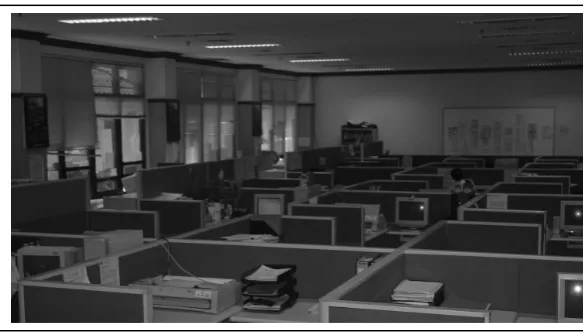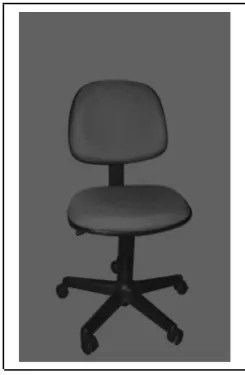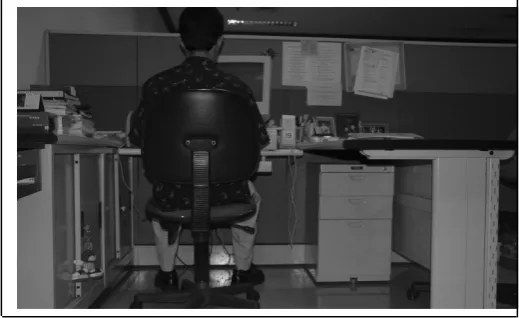by:
Dian Kemala Putri,Widyo Nugroho Working Analysis and Ergonomic Laboratory Industrial Engineering Department – Gunadarma University Jl. Margonda Raya 100, Pondok Cina – Depok 16424 Indonesia
Phone: 62 – 021 7888112 ext. 307 increases employees work spirit. Today, office image’s has influenced by computer age that makes office more simple and efficient. Modern office concept is a workstation, which needs computers and its equipments, reflects working changes which emphases teamwork and open management. Changing of office design and interior that not considering ergonomic approach makes employees feel uncomfort, get fatigue rapidly, and decrease productivity.
This paper is an effort to analyze lay out and workstation design based on ergonomic approach. The object is Administration, Academic, and Student Service Office (BAAK) Gunadarma University. Methods for this paper are direct observation, interview, workstation measurement, and taking photograph at BAAK Office.
Using of workstation concept for office is predicted suitable because it makes office looks simple, formal, only needs limited area, tidy, safe, give convenience, and finally increases working spirit.
Keywords: workstation, BAAK, ergonomic, anthropometri
1. INTRODUCTION
Office interior design dynamically and continuously changes caused by needs or trends. In 1970s – 1980s decade, office interior design almost used same pattern like consists of chairs, rectangular tables, and cabinets in separate office room therefore an employee worked separately from others. But from mid 1990s until now, office interior is influenced by technology development, especially computer technology. Computer age makes office interior is not consist of many filling cabinets, but cleaner, more simple and efficient.
Physically, modern office interior should be open, friendly, tidy lay out, and simple. Today’s office interior is designed compactly consist of table, chair, and filling cabinet in form of Workstation. Workstation reflects today’s work method changes and focuses on teamwork mechanism and team member work performance can be optimalized by rearranged workstation. Workstation also minimized cable connection which usually problem for office.
Administration, Academic, and Student Service Office (AASC Office or BAAK) of Gunadarma University handles and deals with all academic and administration matter and workstation concept has already implemented in this office.
2. METHOD
Object for this study is BAAK Gunadarma University office which has already implemented workstation concept. Data were collected by direct observation, interview, workstation measurement (chairs and tables) and picture taking.
3. RESULTS AND DISSCUSIONS
3.1 Overview of BAAK Gundarma University Office current condition
BAAK Office consists of departments which is divided into several sub departments for example Student Administration and Course Coordination Department consists of Course Scheduling sub department, Course Coordination and Academic Advisors sub department, and Lecturer Coordination sub department.
BAAK Office is designed based on ergonomic concept. Office which is designed without considering ergonomic concept makes employee uncomfort, tired rapidly, and other unexpected condition that finally affects working performance.
BAAK Office has already used workstation which is arranged properly to make employee comfort because BAAK employees spend most of their working time for sitting, writing, and using computer. BAAK Gunadarma University Office is shown in Figures 1 and 2. From these pictures, workstation which is implemented in BAAK Office makes employees easily communicate,looks clean and simple. Electrical and computer cables can be hidden in workstation, so its look tidy.
Figure 1. BAAK Office Layout based on workstation concept
3.2 ERGONOMIC APPROACH ANALYSIS
Ergonomics is concerned with biomechanics, kinesiology., work physiology, and anthropometry. Biomechanics is the mechanic of biological systems, especially the human body. Kinesiology deals with the study of human movement in terms of functional anatomy. Work physiology determines workers physiologyc reactions to their job demands and maintaina the worker’s physiologic cost within safe limits. Anthropomety is mainly concerned with workstation dimensions and the arrangement of tools, equipments, and materials. The anthropometric data consist of worker body dimensions, ranges of motions for arm and legs and muscles strength capabilities (Pulat, 1991).
To obtain maximum worker efficiency and physical well-being, Tichauer in Pulat (1991) suggests seven guidelines for determining workstation dimensions (table 1).
Table 1. Guidelines for Determining Work Station Dimensions
1. Consider body measurement as well as range and strength of movements of the kinetic elements involved in a task.
2. Take account of the full range of body measurements of the spesific working population involved in a task.
3.
Recognize the differences of sex, ethnic groups, and educational or social background because they affect spesific types of manipulative skills.4. Determine by biomechanical analysis the optimal position of an operator with regard to equipment controls.
5.
Provide maximum postural freedom in task design, especially for repetitive work situations.6. Avoid standing on the toes and torsion or sideways bending of the trunk.
7. Refrain from performing a task on a strip 3 inches (7.6 cm) wide from the border of the bench which is closest to the operator.
3.2.1 Implementation of Workstation concept at BAAK Gunadarma University Office
Workstation is known as room partition which can be divided into two different systems namely
panel system (independent panels) and desking system (panels are connected to working desk).
Panels height are varied between eye level and higher. For open space office, partition panels function as massive wall replacement (Sulistiono, 2004).
BAAK Office can be categorized into panel system using light dan simple materials therefore can be arranged easily appropriate to employee’s needs. By implementing workstation concept, office interior looks simpler, formal, and only need limited space for each employee. BAAK Office looks tidy and clean because by implementing workstation concept, cabels of computers, printers, scanners, faximiles, and others electricals can be hidden.
Open space office type which is implemented in BAAK Office conducts employees teamwork, make communication easily and also conducts good relationship between employees and with their supervisor. Exclusivity can be avoided by this system and supervisors easily control their staffs. Massive walls by this system can be reduced by placing several transparency glasses that makes office bigger and more open.
Chairs size should be based on appropriate anthropometric data. Chairs type and size which are used at BAAK Office are shown in Figure 3.
Figure 3. Chairs type which are used at BAAK Office
Working seat at BAAK Office can be categorized ergonomic because equipped with back seat that well support lumbar and its height adjustable. Working seat can be categorized ergonomic if employee who sitting on it still comfort at least four hours non stop. If less than four hours, this working seat is not appropriate to body shape and human movement needs.
Working seat at BAAK office similar to seat type which was developed by Joan Duncan, Prof. Dfergusson, and P. Peach in Australia, known as Duncan Chair. Dimension comparison of Duncan Chair and BAAK working seat are represented in Table 2.
Table 2. Duncan Chair and BAAK working seat dimension
Features Duncan Chair*) BAAK Working Seat
Seat height (adjustable) 37 – 46 37 – 50
Seat widht 46 48
Seat length 38 40
Backrest bottom height 50 – 125 54
Backrest widht 38 45
Backrest/seat angle 85 – 1150
Source: *) CG Drury and BG Coury, 1982
BAAK Office working seat has met criterias of ideal working seat according to Nurmianto (2003) that are:
(1) product stability because seat is supported by five legs / axes; (2) product strenght, shown by compact and strength design; (3) adjustable;
(4) has back rest
(5) functionality because seat support different positional; (6) covered by soft materials on backrest and sitting area; (7) appropriate seat depth between popliteal and buttock;
BAAK Office desk design is not ergonomic yet because it is non-adjustable one, therefore small size operators must heightened their seat height to avoid uncomfort their angle position and need footrest to reduce foot fatigueness. Desk height must be compatible with operator height, whether standing or sitting. When the working desk is too high, operator must frequently lift their shoulder up, and this may cause painfull cramps near the shoulder blades and in the neck and shoulders. On the other hand, when the working desk is too low, the back must excessively bowed and this causes backache. Consequently, the working desk design must adjustable. The table or work surface should be no higher than the height of the elbow to the floor, for a seated person. Konz (1983) recommends three different approaches to determine proper work station height: (1) make available several work station or work surface heights, (2) adjust the worker’s elbow rather than the height of the work station, and (3) adjust the work on the workbench.
Usually people rests their arms at desk in reading and writing activity, so is needed working desk surface higher. Grandjean (1986) recommended 740-780 mm (man) dan 700-740 mm (woman) for table height. The working desk height in BAAK office is 750 mm, Keyboard table height from floor is 710 mm and thick table 35 mm. A.Cakir et al, (1980), Height desk 720 mm for Visual Display Terminal. Height working desk and table thick are designed by anthropometric data especially for dimension of elbow height-sitting and height popliteal is added by allowances shoe heel.
Based on Anthropometric Indonesian Population data from interpolation British and Hongkong Population (Pheasant, 1986) to Indonesian Population (Suma’mur, 1989) in Nurmianto (1991) dimensional to elbow height (sitting) are:
Dimension 14 (popliteal height) + Dimension 9 ( elbow height-sitting)
403 + 231 = 634 mm (Man)
382 + 229 = 611 mm (Woman)
Asumsi coefisien of varian 4.5%, 95th percentile: 634 + (1,645 x 0.045 x 634) = 681 mm (Man) 611 + (1,645 x 0.045 x 611) = 656 mm (Woman)
Adding (shoe heel) 25 mm (man) and 40 mm (woman), 95th percentile, elbow height is 706 (pria) and 696 (wanita).
Ergonomic office desk is not only square one but must have appropriate angle and roundness. Office desk shape is varied from simple one until equipped with cabinet for certain purposes. Today’s, there is free desk system, a desk system that can be used by everobody and equipped with plug and play system therefore support intra or internet connection (Sulistiono, 2004).
BAAK Office cabinet is designed integrated with computer desk (Figure 4). Cabinet shape is designed integrated with desk makes look tidy and ergonomic because there is still space for adult knees according to recommendation 95th percentile of footstep size until knee height (sitting).
3.2.3 Sitting position
A seated position has a number of advantages over a standing position, such as lower physiologic load when sitting, reduced muscular load required to maintain body posture, and improved blood circulation. Kvalseth (1985) maintains that seated operation is preferable for jobs that require:
o Fine manipulative hand movements
o A high degree of body stability and equilibrium o Precise foot control action
o When all materials and tools are located within the seated work space o Heavy material handling
o Fixed body posture for extended time periods
Sitting position BAAK Office employee are shown in figure 5.
Figure 5. Sitting position BAAK Office employee
BAAK Office employee usually sitting approximately six hours/day and most of their time working with computer. Prolonged sitting may cause painfull cramps near the shoulder blades,in the neck and in the muscle of the back. According to Nurmianto (2003), not appropriate sitting position causes several back pains, kyphosis or lordosis. Kyposis often caused by unwell reading sitting position. Adjustable back rest for back supporting reduce kyposis and back pain.
Most of all tasks in BAAK office were using computers. Monitor, keyboard, and mouse surface & positions should be placed in comfort zone. Monitor and keyboard are positioned to allow hands,forearms to remain straight level. When operator’s hands are on keyboard, upper arm and forearm should form right angle; Wrong positions risk for wrist, arm, neck and back. Examples of computer wokstation problems are extreme wrist flexion, extreme static shoulders, and extreme neck flexion.
According to Nurmianto (2003), Procedur and Recommendation for design in Computer Workstation are:
Seat height should not be greater than the length of the lower leg measured from the floor to the inside of the knee bent at 900angle.
Up and down back rest to support the lumbar region. Adjust height table and the angle formed at the elbow is 900 Choose range fit for monitor computer (450-500 mm) Place monitor at left or right to fit for use.
Adjust monitor height to eye angle 10-200
Choose position of monitor surface and the angle formed 900 relative to eye line
Adjust monitor position at angle 900 to protect from reflection
Place all workstation equipments meet operator’s requirement to have high productivity.
4. CONCLUSION
1. Office interior design using “workstation” concept is appropriate for modern office which implementing teamwork and open, look simple, formal, only needs limited space, and tidy. 2. BAAK office working seat and integrated cabinet can be categorized ergonomic but
working desk not yet ergonomic.
3. Sitting and working with computer for hours cause several fatigueness and It risks for wrist, arm, neck and back.
5. REFERENCES
Drury CG and BG Coury. 1982. A Methodology for Chair Evaluation. Appl. Ergonomic. 13:195. Galer IAR. 1987. Applied Ergonomic Handbook. Butterworth & Co. Publ. Ltd. London.
Grandjean E. 1986. Fitting in the task in the Man. Taylor & Francis Press.
Konz S. 1983. Work Design:Industrial Ergonomics. 2 nd ed. Columbus, OH:Grid Publishing. Kvalseth TO. Workstation design. In: Alexander DC and Pulat BM, eds Industrial Ergonomics:
A Practitioners Guide. Norcross, GA: Institute of Industrial Enginerers, 1985.
Pulat and Alexander DC. 1991. Industrial Ergonomic Case Studies. McGraw-Hill,Inc. New York. Tichauer ER Sulistiono Y. 2004. Interior Kantor yang tidak rumit. Jakarta.


